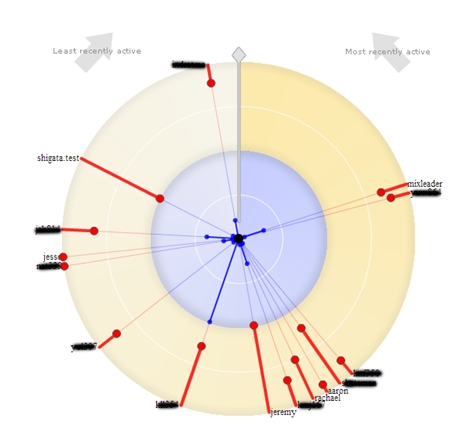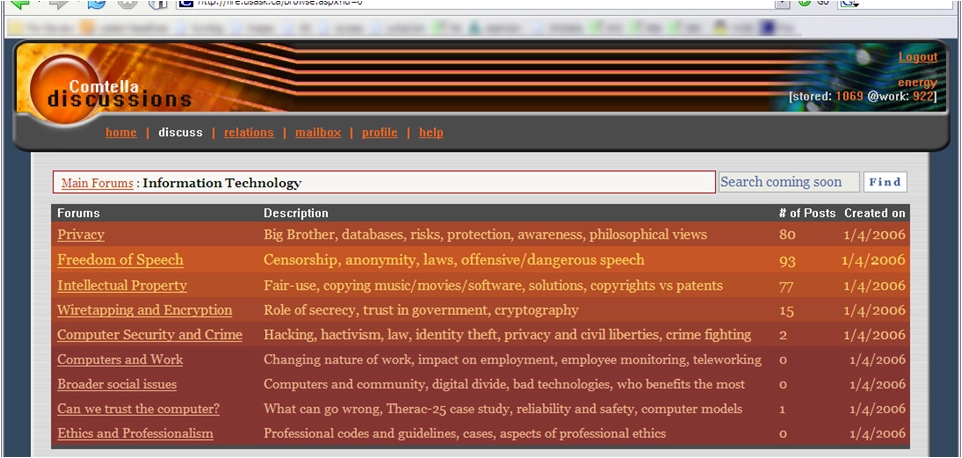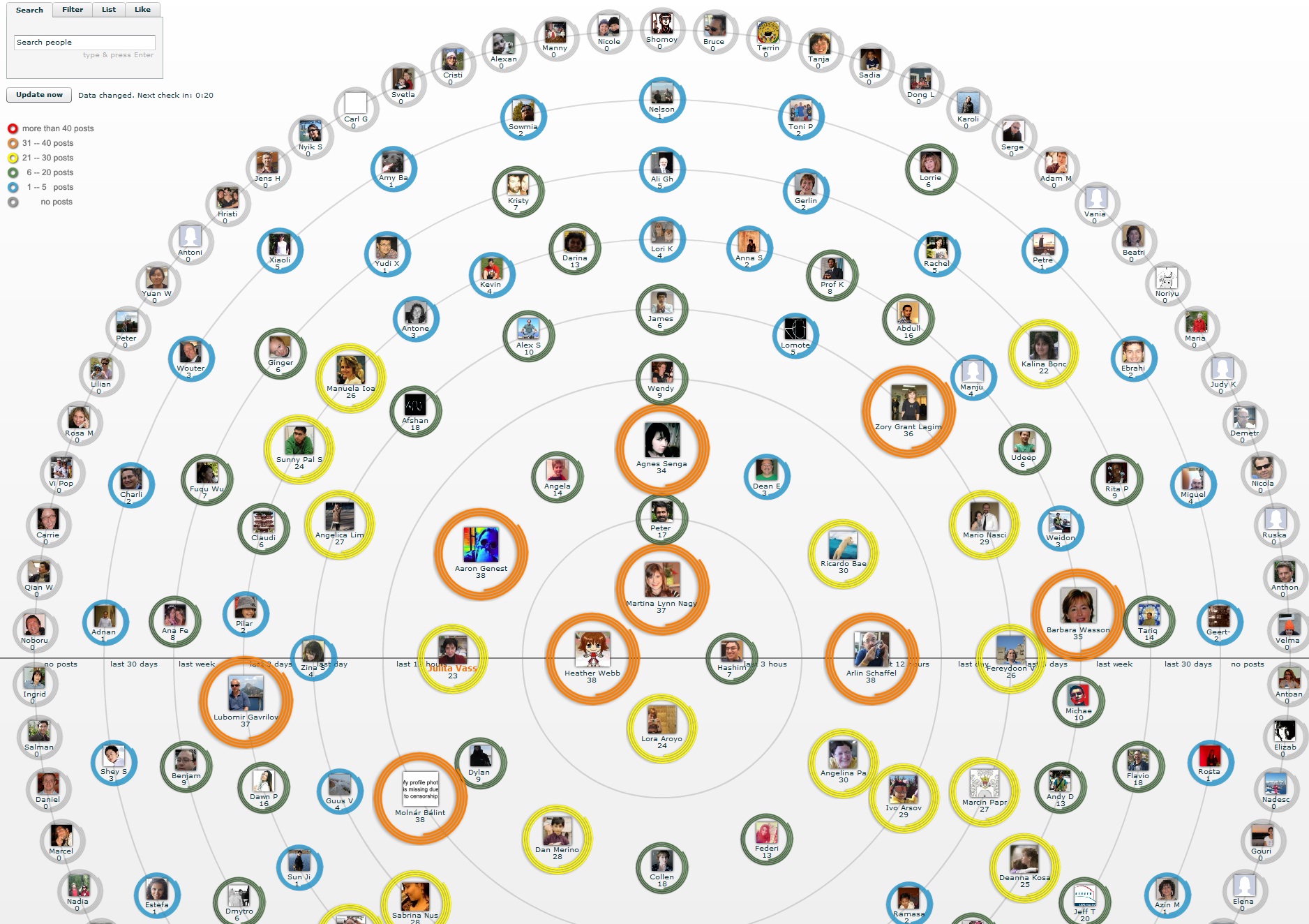Social Recommender Systems
Participants:
- Andrew Webster, M.Sc. Student (2005-2007)
- Yuan Wang, M.Sc. Student (2008-2010)
- Jie Zhang, Post-doctoral fellow (2009)
- Shi Shi, M.Sc.Student (2009-2011)
- Sabrina Nusrat, M.Sc. Student (2010-2012)
- Udeep Tandukar, M.Sc. Student (2010-2012)
- Shaikhah Al-Otaibi, Ph.D. Student (2010-2016)
- Thomas Largillier, Post-Doctoral fellow (2012)
- Nagulendra Sayooran, M.Sc. Student (2012-2014 )
- Mina Mousavi, M.Sc. Student (2019-2022)
- Amirabbas Jalali, M.Sc. Student (2019-2022)
- Elaheh Jafari, Ph.D. Student (2022-ongoing)
- Julita Vassileva, supervisor
The area of Recommendations is being explored in several graduate projects.The main themes specific to our approaches are:
- modeling relationships among users and using them to filter / recommend information
- creating interactive visualizations of the relationships between users, and allowing them to manipulate them thus increasing or decreasing the influence that other users have on them.
KeepUp is a recommender system for RSS feeds based on a new hybrid mechanism suitable for recommending new items where few ratings are available. The recommender mechanism includes an interactive visualization of how the choices the user makes influence the others and reversely, how their choices influence the recommendations received by the user. The user can manipulate graphically the level of influence the others have on his or her recommendations. Webster A.S., Vassileva J (2007a) The KeepUp Recommender System. in ACM RecSys 2007, 173-177.(submitted and accepted as short paper, short papers acceptance rate 60%). Webster A.S., Vassileva J. (2007b) Push-Poll Recommender System: Supporting Word of Mouth, (to appear) in Proceedings User Modelling, UM2007, Corfu, Greece, June 25-29, 2007. |
|
Comtella-D is a disucssion forum that motivated participation by modeling and visualizing
the asymmetrical relations formed when reading, evaluating, or commenting
other community member's contributions. In addition to Comtella-D proposed a novel recommender
mechanism for interesting articles based on new concept of "community energy."
In this mechanism users ratings of others' contributions was visualized by highlighting the
contributions in the interface of the discussion forum using different colour shades depending
on the rank of the contributions
(based on the ratings received). The colour shades represented different levels of
heat/energy.When users rated a contribution positively (like), it became "hotter", and
therefore, in brighter shade of orange. Contributions that were rated low, lost energy, thus
became colder and taking a shade in brown, or purple-blue. The overall level of energy inthe
community depended on the time since the last post, and it was decremented gradually to reflect
the "cooling off" of topics, as time passed. Webster A.S., Vassileva J. (2006) Visualizing Personal Relations in Online Communities, in Adaptive Hypermedia and Adaptive Web-Based Systems, Dublin, Ireland, Springer LNCS 4018, 223-233. Further work explored machine learning based on the data accummulated in Comtella-D, to find out if it is possible to generate rules to recommend interesting posts to users, based on who the poster is, the topic of the post, how long ago it was posted etc. Abel F., Bittencourt I., Henze N., Krause D., Vassileva J. (2008) A Rule-Based Recommender System for Online Discussion Forums, in Proceedings Adaptive Hypermedia, AH'2008, Hannover, Springer Verlag, 12-21. (full paper, acceptance rate 30%) Coneho, R., Ruiz, A., Barros, B., Vassileva J. (2008) Towards a group model for Learning Communities. First steps with the Comtella-D Collaborative Learning Community, in Proceedings ICALT'2008, Santander, Cantabria, Spain, IEEE Press, 905-909. (full paper, acceptance rate 29.65%).
|
SocConnect is a recommender for social network news feeds. Users of social networking sites, such as Facebook, Twitter, Pinterst, etc. suffer from "social network overload", trying to keep with the updates of their friends. “SocConnect” (Social Connect) is a user-centric system aggregating social data from different SNSs and allowing users to create personalized social and semantic contexts for their social data. Users can blend and group friends on different SNSs, and rate the friends and their activities as favourite, neutral or disliked. SocConnect then provides personalized recommendation of friends’ activities that may be interesting to each user, using machine learning techniques. A prototype is implemented to demonstrate these functionalities of SocConnect. Evaluation on real users confirms that users generally like the proposed functionalities of our system. Yuan Wang, Jie Zhang, Julita Vassileva (to appear) SocConnect: A Personalized Social Network Aggregator and Recommender, Information Processing & Management. (accepted August 2012) We applied four different machine learning techniques on previously rated activities and friends
to generate personalized recommendations for activities that may be interesting to each Wang Y., Zhang J., Vassileva J. (2010) Towards Effective Recommendation of Social Data across Social Networking Sites, Proceedings 14th Int. Conf. Artificial Intelligence Systems, Methods, Applications (AIMSA’2010), Varna, Bulgaria, Springer LNCS 6304, pp. 61-70. |
Recommending service providers using trust and gossip.
Nusrat S., Vassileva J. (to appear, accepted in June 2012) Simulating a Trust-Based Service Recommender System for Decentralized User Modeling Environment. Int. J. Trust Management in Computing and Communication, Inderscience Publishers. Nusrat, Sabrina (2011) RECOMMENDING SERVICES IN A DIFFERNTIATED TRUST-BASED DECENTRALIZED USER MODELING SYSTEM. MSc. Thesis, University of Saskatchewan. Nusrat S., Vassileva J. (2012) Recommending Services in a Trust-Based Decentralized User Modeling System. Advances in User Modeling: revised selected papers from UMAP 2011 workshops. Springer Verlag LNCS7138, pp.230-242. |
Ringsis a novel visualization for the updates stream of Facebook. Users of social network sites, such as Facebook, are becoming increasingly overwhelmed by the growing number of updates generated by their friends. It is very easy to miss potentially interesting updates, it is hard to get a sense of which friends are active and especially, which are passive or completely gone. Such awareness is important to build trusted social networks. However, the current social network sites provide very awareness of these two kinds. We proposed an interactive method to visualize the activity level of friends. It creates a time- and an activity-pattern awareness for the user, as well as an awareness of the lurkers. The proposed visualization help the user to browse her friends depending on how recently they have posted and how much interactions their updates have caused.
Shi S., Largillier, T. and Vassileva J.(2012) Keeping Up with Friends’ Updates on Facebook, Proc. Collaboration and Groupware CRIWG’2012, Duisburg, Germany, Sept. 17-29, 2012. (short paper 8 pages), Springer Verlag LNCS 7493, pp. 121-128. |
Recommending Updates in Decentralized Social Networks by Modeling Interpersonal Relationships between Users We developed a novel peer-to-peer architecture for decentralized Online Social Network and a mechanism that allows each node to filter out irrelevant social data, while ensuring a level of serendipity, by letting important information pass, even if it does not fall in the areas of interest of the user. The evaluation of the approach, using an Erlang simulation with 2318 nodes shows that it works as it was designed to: with the increasing number of social data passing through the network, the nodes learn to filter out irrelevant data, while serendipitous important data is able to pass through the network. Tandukar U., Vassileva J. (2012) Ensuring Relevant and Serendipitous Information Flow in Decentralized Online Social Network. Proc. AIMSA’2012, 15th biennial conference on AI methods Systems, Applications, Varna, Bulgaria, Sept 12-14, 2012, Springer Verlag, LNAI 7557, pp. 79-88. (33% acceptance rate, *1 of 8 best paper nominees*) Tandukar, U. and Vassileva, J. (2012) Selective Propagation of Social Data in Decentralized Online Social Network. In Advances in User Modeling: revised selected papers from UMAP 2011 workshops. Springer Verlag LNCS7138, pp.213-224. |
MadMica: a Decentralized Social Network with Personalization based on Friendica. Filter Bubble visualization and user control of recommendations. Sayooran Nagulendra, Julita Vassileva (2014) Understanding and controlling the filter bubble through interactive visualization: a user study. Proceedings of the 25th ACM conference on Hypertext and social media, 107-115. Nagulendra S., Vassileva J. (2015) Providing Awareness, Explanation and Control of Personalized Filtering in a Social Networking Site. Information Systems Frontiers. Vol. 18, Pg. 145-158 (2016). |




